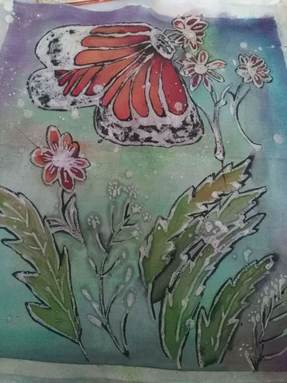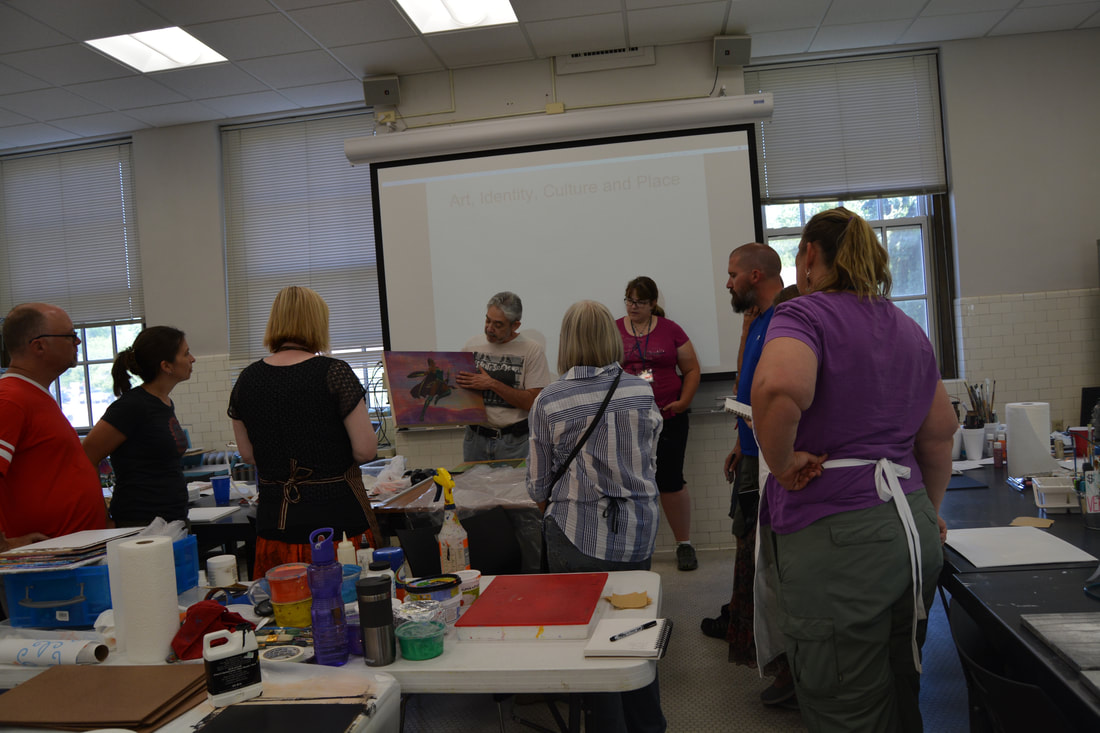ArtSource Summer Institute 2018
Journey into the Unknown: Making, Adventure, Passion (MAP)
A Reflection and Extended Inquiry into the 2018 Summer Institute Theme
A Reflection and Extended Inquiry into the 2018 Summer Institute Theme
|
by Michelle Zuccaro
What are the feelings that we first experience when facing Unknowns in our lives? What do you do with these feelings? How do we move through times of unknowing to forge a path? When do we choose to take on the unknown and when does it accost us uninvited? We all navigate the unknown daily, consciously and unconsciously. We all have big and small successes and challenges related to the unknown. As artists we face “what’s next?” or the classic “blank canvas” and as teachers we face the anticipation of meeting many eager faces as we start a new school year. Have you experienced any of these vignettes as you approach the unknown? |
|
John Wesley Powell was no stranger to journeying into the unknown as he put together an expedition to discover the Colorado River. He reflects:
|
In this reflection he conveys the many contrasts that arise when facing the unknown.
|
At the ArtSource Summer Institute participants explored the ideas of the “unknown” through Mapping-making, adventure and passion with Lance McClure’s guidance and through inspiration by the examples of guest artists: Tony Ortega, Mark McCoin, Katie Hoffman, Valerie Salvarie, Theresa Haberkorn, and Armando Sliva aka, Art Man Do. We explored Journeying into the unknown through lenses as artists, researchers, and teachers. Through the structure of the institute the unknown became less daunting; we dove in head first making art together, exploring ideas, sharing stories of our lives, trying new techniques and mediums, admiring each other’s talents and skills, empathizing with personal struggles, common challenges and experiences, and encouraging each other in our growth as people, as artists and as teachers.
|
Our artist guests fed us along the way with their stories about their lives, experiences and art making. All of the artists that visited had ways of managing their practice as artists such that the unknowns have become less daunting at least in relation to making art. They have found ways to create a sustaining source for ideas, artistic development and production. Each artist has developed a sort of patterned structure or habits in making art. Tony Ortega pulls content and ideas from his sense of community, culture and place by depicting gathering places. He also does cultural spin offs of American icons superimposing Chicano/Latino icons to speak about cultural diversity. These themes are rich and personal and therefore compelling to him and they also communicate poignantly
|
Mark McCoin’s exploration of sound transports those who experience his work into a sense of space. McCoin’s world is illuminated by paying attention to sound. He develops a sense of space through working with ideas of Certainty and Uncertainty, Certainty as a loop of sound, something that repeats and Uncertainty as layered on top creating tension. He describes sound as malleable and sculptable. He is passionate about exploring sound not as music but as moving images that play with time. He structures his artistic expression and experience of the world through sound; hearing it, making it, recording it, and producing new combinations and experiences.
Katie Hoffman is an oil painter. She manages her blank canvas by first marbling, gouging and/or splattering her canvas. After this ground has been created she studies the textures and gestures and finds the image. Like reading tea leaves, the image is presented to her and she paints it. She describes this process as having something to “react against” or “something to respond to.” This creates an ongoing dialogue and limitless source of images for her. She always has canvases marbled and splattered so that she has something to prompt her next artwork. We viewed a video called “Jerry’s map.“ Jerry Gretzinger has a detailed way of managing his ongoing artistic map making. With a deck of cards he has created instructions. He does whatever the instructions tell him to do. He experiences these cards as a type of “god” in relation to his art making. Within the experience of following the directions there are spaces for new ideas; this has sustained his map making for decades.
These artists have made choices to structure their practice through themes, creating habits of working and choices on what they pay attention to, study and play with and even by creating instructions in order to focus, but also to help with the unknown. The Unknown, as something that is rather ethereal, something that can’t be grabbed out of thin air; it is unnamed, unrecognizable, or anonymous and can be difficult to harness. How do we grasp it and make use of it? Here is my visualization of how we as artists, researchers and teachers grapple with the unknown (see right). |
"...she studies the textures and gestures and finds the image. Like reading tea leaves, the image is presented to her and she paints it. She describes this process as having something to “react against” or “something to respond to.”
|
We might visualize structures such as a web, a colander, a filter or maybe a bunch of lenses through that we look through. As we encounter the unexpected, unnamed, we distill it into experience as art, learning or into creative new connections. What might your structure look like? How will it help you handle the unknown? You get to construct it. I might need to flip mine and add heat with the “distilling” idea.
What motivates us to take steps into the unknown; is it survival? Desire? Needs? The search for beauty, meaning, or understanding? The desire for belonging and community? With each unknown that comes our way there are a variety of paths gently sketched in; they are choices. The path deepens when we make choices thus creating a map of our life. These choices lead to new opportunities, new unknowns; the edge of this map is endless. Beau Lotto, a neuroscientist describes the step into uncertainty as exciting. His best advice is to “engage the world.” By engaging the world, you gain the opportunity for deeper meaning. “We have to act in the world to understand it.”(Lotto, 2017, p. 16) This is the link to passion and adventure and creativity.
What motivates us to take steps into the unknown; is it survival? Desire? Needs? The search for beauty, meaning, or understanding? The desire for belonging and community? With each unknown that comes our way there are a variety of paths gently sketched in; they are choices. The path deepens when we make choices thus creating a map of our life. These choices lead to new opportunities, new unknowns; the edge of this map is endless. Beau Lotto, a neuroscientist describes the step into uncertainty as exciting. His best advice is to “engage the world.” By engaging the world, you gain the opportunity for deeper meaning. “We have to act in the world to understand it.”(Lotto, 2017, p. 16) This is the link to passion and adventure and creativity.
|
As we engage the world, reacting through the structures we have in place, the unknown naturally unfolds. We react to these unknowns with passion and step out into adventures sometimes timidly, sometimes with confidence and sometime with exuberance. I certainly experienced each of these at moments during the Institute’s adventures into the unknown. The great thing is that the unknown is temporary, once it is siphoned through your structures it becomes known and that can support you as you approach other unknowns. Lotto does warn that with rigid rules and habits we lose the stimulating aspect of uncertainty, we lose freedom and “nothing interesting ever happens without active doubt.” (Lotto, 2017, p. 11) So just be sure to allow the structures you create to be flexible. Like Gretzinger, be sure to have a card that is a “shuffle the deck” card, or “redraw a tile,” or “create a new card” to keep things interesting.
I am inspired, propelled, motivated and touched by the community of art educators here in Colorado. The depth of commitment, passion and willingness to adventure as colleagues and comrades is awesome! Wishing you all the best at the start of this school year. May your roads and the life map that you are creating be stimulating, may you create flexible structures that guide your art making and choices in life such that you engage the world actively, may you have exciting things to respond to that propel you into deep meaningful connectedness to the world and satisfying creative activity. Now my children are asking me about the next unknown that I need to decide on: “What’s for Dinner?!” |
Dolnick, E. (1952). Down the Great Unknown: John Wesley Powell’s 1869 Journey to discovery and tragedy through the Grand Canyon. Harper Perennial
Gretzinger, J. [Jerry Gretzinger]. (2009, September 24). Jerry’s Map [Video file unknown]. Retrieved from https://vimeo.com/6745866 Lotto, B. (2017). Deviate: The Science of Seeing Differently. New York, NY: Hachette Books. |
More on ArtSource's Summer 2018 Guest Artists
|
Featured Artists:
Mark McCoin: Named one of Westword's, 100 Colorado Creatives in 2013. Read more about him here and visit his website at: www.markmccoin.com Tony Ortega: Named one of Westword's, 100 Colorado Creatives in 2017. Read more about him here and visit his website at: www.tonyortega.net Other Creative Leaders and Speakers: Katie Taft: Learn more at Westword's Creative 100 and visit her Facebook page at Katytaftartmaker Katie Hoffman: visit her website at katiehoffman.com Valerie Savarie: visit her websites at valkariefineart.com and valeriesavarie.com Speakers: Art Man Do (artist Armando Silva) will speak with participants and offer a tour of his nearby gallery. Connie Steward, UNC professor/Area Head Arts Educator and Chair of Visual Arts Revision Committee led a discussion about the new revisions to the Colorado Visual Art Standards. |
|











